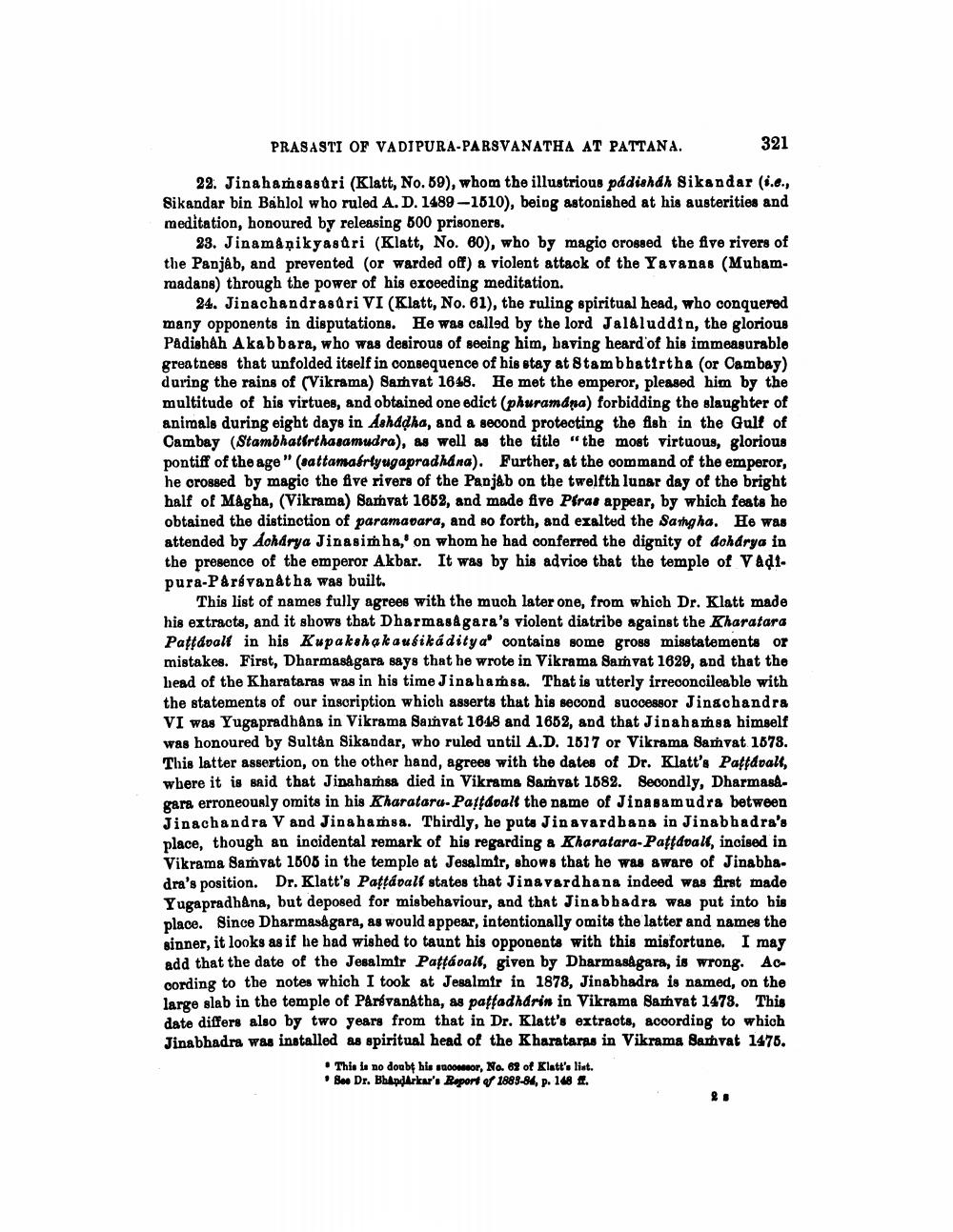________________
PRASASTI OF VADIPURA-PARSVANATHA AT PATTANA.
321
22. Jina hamsastri (Klatt, No.69), whom the illustrious pådishda Sikandar (1.e., Sikandar bin Bahlol who ruled A.D. 1489-1510), being astonished at his austerities and meditation, honoured by releasing 800 prisoners.
23. Jinamåņikyasari (Klatt, No. 60), who by magic crossed the five rivers of the Panjab, and prevented (or warded off) a violent attack of the Yavanas (Mubam. madans) through the power of his exceeding meditation.
24. Jinachandrasuri VI (Klatt, No. 61), the ruling spiritual head, who conquered many opponents in disputations. He was called by the lord Jalaluddin, the glorious Padishah Akabbara, who was desirous of seeing him, baving heard of his immeasurable greatness that unfolded itself in consequence of his stay at &tam bhatirtha (or Cambay) during the rains of Vikrama) Samvat 1648. He met the emperor, pleased him by the multitude of his virtues, and obtained one edict (phuramapa) forbidding the slaughter of animals during eight days in Ashadha, and a second protecting the fish in the Gull of Cambay (Stambhatirthasamudra), as well as the title "the most virtuous, glorious pontiff of the age" (sattamarlyugapradhana). Further, at the command of the emperor, he crossed by magic the five rivers of the Panjab on the twelfth lunar day of the bright half of Magha, (Vikrama) Barvat 1662, and made five Pfras appear, by which feats he obtained the distinction of paramavara, and so forth, and exalted the Sangha. He was attended by Aoharya Jinasimha, on whom he had conferred the dignity of dohárya in the presence of the emperor Akbar. It was by his advice that the temple of Vadi. pura-Parévanátha was built.
This list of names fully agrees with the much later one, from which Dr. Klatt made his extracts, and it shows that Dharmasagara's violent diatribe against the Kharatara Pattavalt in his Kupakshak aufikádity a contains some gross misstatements or mistakes. First, Dharmasagara says that he wrote in Vikrama Samvat 1629, and that the head of the Kharataras was in his time Jinahamsa. That is utterly irreconcileable with the statements of our inscription which asserts that his second successor Jinachandra VI was Yugapradhana in Vikrama Sauvat 1648 and 1652, and that Jinahamsa himself was honoured by Sultan Sikandar, who ruled until A.D. 1617 or Vikrama Samvat 1678. This latter assertion, on the other hand, agrees with the dates of Dr. Klatt's Pattával. where it is said that Jinahamsa died in Vikrama Samvat 1682. Secondly, Dharmasagara erroneously omits in his Kharataru-Pattdoalf the name of Jinasamudra between Jinachandra V and Jina hamsa. Thirdly, he puta Jinavardbana in Jinabhadra's place, though an incidental remark of his regarding a Kharatara-Pattdvall, incised in Vikrama Saṁvat 1605 in the temple at Jesalmir, shows that he was aware of Jinabhadra's position. Dr. Klatt's Pattávali states that Jina vardhana indeed was first made Yugapradhana, but deposed for misbehaviour, and that Jinabhadra was put into his place. Since Dharmasagara, as would appear, intentionally omits the latter and names the Rinner, it looks as if he had wished to taunt his opponents with this misfortune. I may ada that the date of the Jesalmir Pattávall, given by Dharmashgara, is wrong. According to the notes which I took at Jesalmir in 1878, Jinabhadra is named, on the large slab in the temple of Parsvanatha, as patfadhdrin in Vikrama Samvat 1478. This date differs also by two years from that in Dr. Klatt's extracts, according to which Jinabhadra was installed as spiritual head of the Kharataras in Vikrama Samvat 1476.
• This is no doubt his 19cmeor, No. 62 of Klatt's list. Seo Dr. Bhandarkar's Report of 1883-84, p. 148 I.




